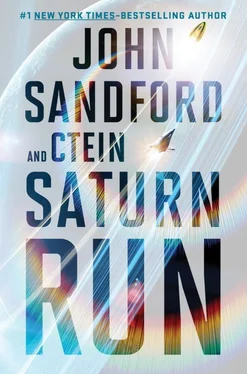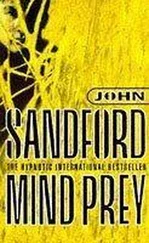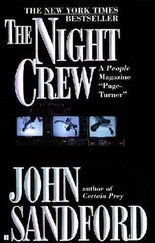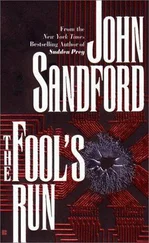“Good job,” Sandy said. He yawned. The I/O link went down and Wurly said, “Data transfer through the I/O link is now complete.”
“Thank you,” Clover said. “Wurly, I have—”
Fang-Castro crashed the party. “For all members of the contact crew, the I/O record is now complete, or so we have been told. Return to the Nixon immediately, or make arrangements to hitchhike back home with the Chinese.”
“That’s us,” Sandy said on the private link. On the public link, he said, “Yes, ma’am. It’ll take a minute to pack up my cameras.”
Clover asked, “Wurly, do you have any final message for the people of Earth?’
“Yes.”
“What is it?”
“Hello, people of Earth.”
Sandy: “I think that’s a glitch. It’s the first glitch we’ve had from him.” He patted the jukebox on its carapace. “Thanks, pal.”
A tech came out of the room where the I/O harness was attached.
He said, “Let’s haul butt.”
Thirty-seven hours after Fang-Castro first spoke to Zhang, she called back: “We are starting our main engines. We thank you for your courtesy in waiting for our departure.”
Zhang nodded. “May you have the best of luck in your return. We hope to see you there someday.”
“Someday,” Fang-Castro said.
Zhang winked out.
____
The Nixon left Saturn on Sunday, April 8, 2068, but it wasn’t a day of rest. As soon as Fang-Castro issued the burn order, the VASIMR engines set about pushing the Nixon out of the Saturnian system.
The exit trajectory was similar to the one that had taken them away from Earth more than eight months before—a long, slow spiral outward while the VASIMRs piled on enough thrust to finally break the ship free of Saturn’s grip. Unlike that launch, this was no tentative departure, no slow and careful ramping up of the reactors and the engines. In less than two hours, Engineering had the engines sucking down every bit of power Reactor 1 was capable of generating.
The engine ignition that signaled their departure from Earth had been a novel experience and symbolically profound for everyone on board, unimpressive as it was to the senses. Eight months later, it was another story. Firings were now routine; in truth, most of the crew had had their fill of engine starts and stops. Of space travel, really. They just wanted to get home.
As the Nixon gradually put distance between itself and the alien depot in the Maxwell Gap, it pushed out of the ring plane as it expanded and inclined its orbit. An hour of thrust had it a thousand kilometers from the depot and the Chinese. Halfway through its first orbit, as the Nixon threaded its way back through a gap in the ring plane, they were far enough from the alien constellation that it was invisible to the naked eye.
By the following morning, the Nixon had completed three outward spirals on its winding path to free flight. It was a comforting fifteen thousand kilometers farther out, in an orbit that was inclined four degrees to the ring plane. Another day’s worth of thrust doubled that. Saturn was still an overwhelmingly impressive presence in their sky, but it was dwindling. It remained paramount for the engineering and navigation teams that had to calculate and recalculate the trajectories that would let them safely thread the gaps in Saturn’s rings on each half orbit’s ring plane crossing, but even their vital job was becoming routine. By the end of Day Three, they’d be safely beyond the outer limits of the A Ring, where the ring plane was mostly empty space.
Just as when it had left Earth, the Nixon ’s velocity dwindled as their orbit expanded. That peculiar logic of orbital mechanics by now felt normal to the Nixon ’s crew. That trade-off would continue as they spiraled away from the ringed giant, but nine days of this would see them entirely free of Saturn’s pull.
With the Americans leaving, there was no particular reason to rush to the alien planetoid. A number of critical repairs were being completed on the Celestial Odyssey , and Zhang wanted them done before they were distracted by the larger mission. Too many people had already died because of problems with the ship.
The American printer and the extra supply of carbon fiber could be crucial to the effort: the maintenance crew, what was left of them, told Zhang that they could probably repair one of the badly damaged reaction-mass tanks.
They already had plans, the result of a flash-design program in Wenchang. They were also looking into the possibility of fabricating tankless tanks out of water-ice taken from the rings, that could be attached to the exterior of the ship, cut up with lasers, and fed into the internal tanks as those emptied on the way back. That was iffy.
Still, things were looking up.
Finally.
____
So they took it slow.
Wenchang ground control was understanding; the politicians, less so. The Americans carried on board a very effective and attractive female propagandist who had given the alien information-bot a cute name, which had inspired a number of retail efforts and three copyright and patent lawsuits. She had also subtly and with humor created the impression that the Americans were the generous, idealistic ones, even providing the Chinese with repair equipment. The Chinese had no answer to that: their own trained propagandist had been off-loaded at Earth, part of the weight-reduction program when the ship was being stripped for speed.
Beijing pressed for action. Since the Americans had investigated only the primary, the Beijing brain trust suggested that Zhang’s crew investigate the rest of the constellation of alien artifacts, as well as the planetoid.
The thinking went like this: Zhang’s crew should gain access to one of the moonlets, taking care not to interfere with its operation, while collecting as much data as possible. If the Americans were to be believed, there would be no aliens there—but then, the Americans hadn’t looked.
If there were aliens aboard the moonlets, let the anthropologists and the diplomats do their job. The military was absolutely not to engage unless they were attacked first and retreat was impossible. First Contact was worth a few human lives.
Absent an alien presence, they should pursue a secondary, and more aggressive, goal. The alien facilities deployed uncountable numbers of small autonomous spacecraft. Some of them scavenged Saturn’s rings, apparently for water ice, and brought it back to some of the moonlets. Others shuttled between moonlets. They appeared to lack armament, or even much in the way of tools.
Ground-based analysis suggested that they were simple collection and transport devices—but however simple they were, they deployed alien tech. The large number of such craft, their small size, and their swarm-like behavior, strongly argued that they were not individually important.
They were the station’s equivalent of ants foraging in the grass. The analysts also guessed one ant would not be particularly missed, as long as the rest of the hill was not disturbed. Capture an ant, preferably alive rather than dead, but either way, get one aboard a tug and get the tug and its treasure back to the Celestial Odyssey .
Because the Americans would be periodically watching the Chinese activity around the alien planetoid, it would be best if they never got a hint that one of the ants had been captured. The ant, after all, would probably become the major piece of alien tech actually back on Earth.
After two days of repair work, Zhang signaled to Beijing his willingness to move toward contact. It seemed little enough to get the politicians off his back, especially since the repairs were going well. He directed Cui to draw up plans for two contact parties, one to investigate the planetoid, the other to look at the rest of the constellation.
Читать дальше








